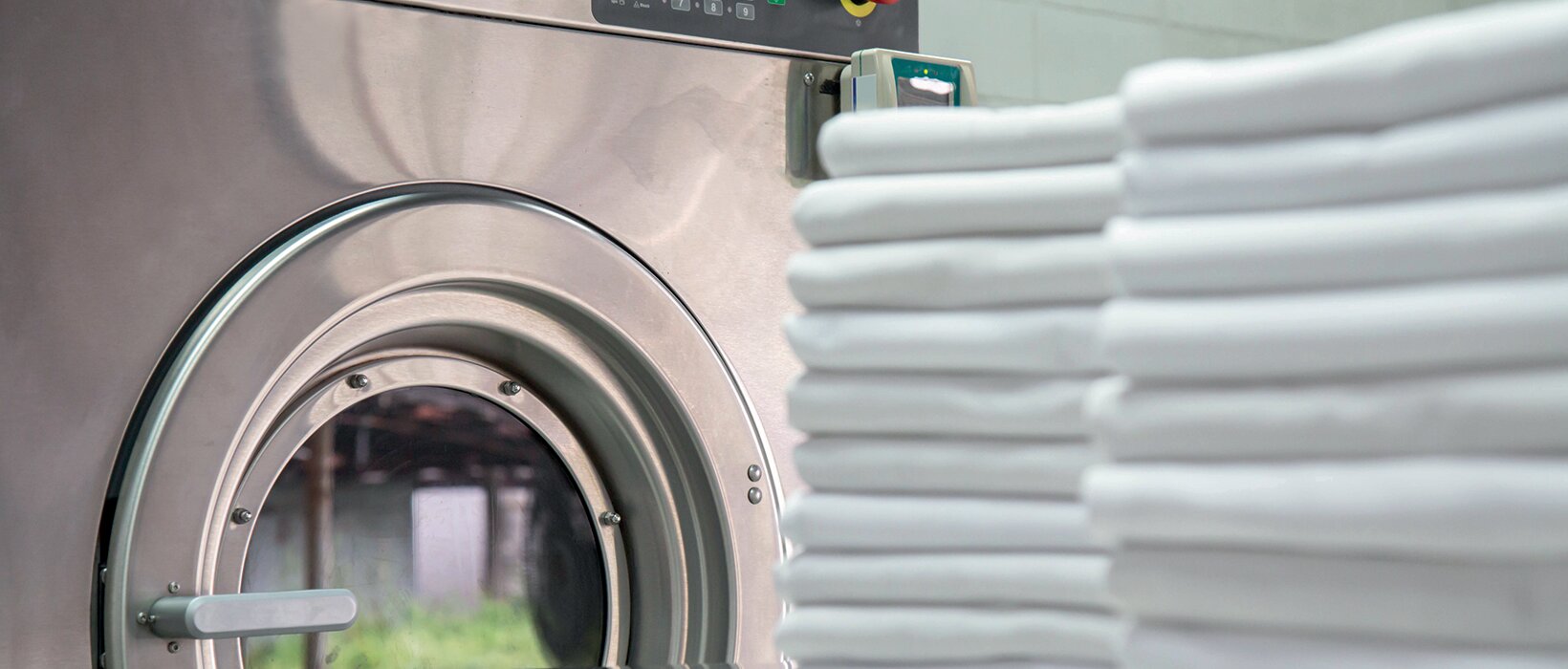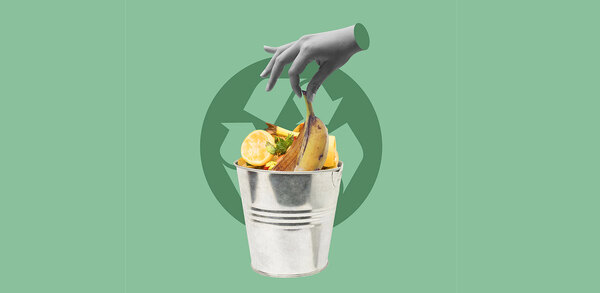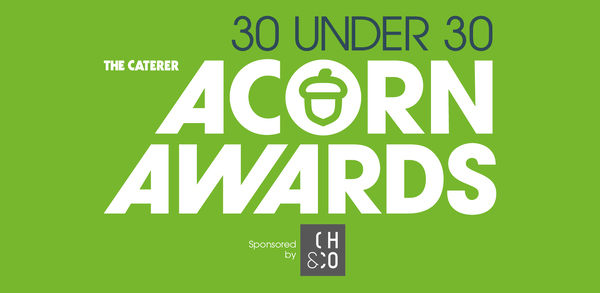Cheat sheets: how to make your laundry operation clean and serene
Cutting wash time, using less detergent and smart dryers all contribute to running a super-efficient, sweet-smelling laundry. Angela Frewin reports on the freshest developments
Clean linen is critical to hotels. In fact, procurement bosses at hotel companies Marriott International and Accor said that “without it, we can’t sell our rooms” at a series of joint round tables held by the Textile Services Association (TSA), UKHospitality and the UK Housekeeping Association.
Multiple surveys have consistently underlined the supreme importance to guests of comfortable and immaculately-laundered bedroom fabrics for sumptuous sleep and bathroom bliss. For the UK laundry care market, researcher Stastisa predicts this sector will be worth £2.11b in revenue this year. However, spiralling bills mean hospitality and laundry operators are seeking more cost-effective ways to meet customer satisfaction and rising demand for sustainability.
Around 90% of hotel operators outsource the job to professional laundries for reasons of cost, time, space and environmental issues, says David Stevens, chief executive of the TSA, which represents commercial laundries and textile rental companies. He adds that investing in equipment, infrastructure and staff training for on-premise laundries (OPLs) costs more than commercial laundries, which benefit from unmatchable economies of scale and investment in the latest resource-saving, fabric- and eco-friendly equipment.
Innovations include continuous batch (tunnel) washers, which use 70% less water than traditional washers, sensors to spot and remove stained items at any stage, automated folding machines for sheets, and electronic radio frequency identification (RFID) tags to keep track of the location and history of every laundry item.
The TSA’s sustainability report reveals that commercial laundries have reduced their use of energy by 31% and water by 60% since 2012. The association is launching a new carbon footprint measurement tool to help it further reduce waste and energy use.
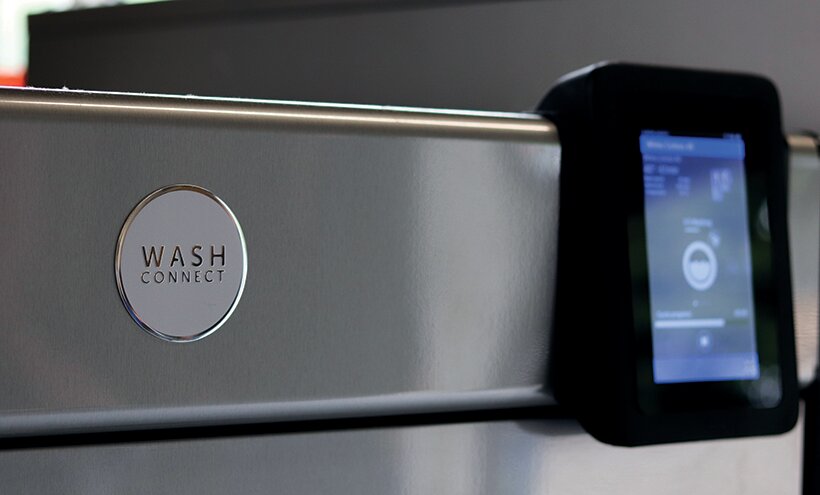
In-house or out
Many hospitality operators prefer to keep control of costs, quality and hygiene in-house, where they are insulated from supply chain disruptions. OPLs also offer the potential for new revenue streams through personalised guest laundry/dry cleaning services.
Freedom from fixed delivery times gives in-house operations more flexibility to reduce turnaround times and react to quality and peak demand requirements, says Jeremy Paul, head of commercial sales at Girbau UK.
“Technology and innovation are adding new impetus to the increasing number of hospitality operators making the move from outsourcing to running their own on-premise laundry,” he says. He estimates that modern, smart laundry equipment designed to perform well while using less water, electricity and detergent on shorter cycles can contribute to long-term cost savings of between 20% and 60%
Girbau’s range of commercial and industrial washers, dryers and ironers include new internet-enabled GS7 Genius washers with 15% lower energy use compared to some competitor machines, saving up to £876 a year, based on eight cycles a day. Their high spin speeds and 450G extraction force can extract more water than other brands’ units, cutting drying time and drying energy use. The Sapphire cloud-based management system gives managers remote access to machine status and data trends, helping them pinpoint efficiency improvements, while smart alarms reduce downtime and catch emerging problems.
A hybrid solution is becoming increasingly popular among WashCo customers with limited space, notes sales manager Debbie Jones. Venues are programming machines to handle robes and towels but continue to outsource bed and table linens that require large multi-roll ironers.
WashCo’s cloud-based WashConnect range provides real-time monitoring and reports on the entire laundry process, while the washers’ dynamic weighing system uses only the necessary levels of energy, water and detergent per load so large machines can launder smaller batches economically. Dryers adjust heat and time parameters to shave up to 12 minutes off a drying cycle.
Leasing appliances is proving popular too, according to Sam Holden, business account manager at Miele Professional: “The flexibility of renting equipment is becoming a crucial necessity for businesses that want to access premium equipment without a significant upfront cost. We have seen an increase in enquiries for rental equipment, highlighting a major trend across the industry during these economically uncertain times.”
Miele’s commercial offer includes the entry-level Smart Biz washing machine for customers running one to three daily wash cycles and compact Little Giants with big 7kg washing and drying load capacities. Its optimised cloud-connected Benchmark range offers short running cycles using an estimated 20% less water than conventional models and reducing energy use by 30% (washers) and 60% (dryers).
Chill out
Professional fabric care and laundry detergents will also cut costs and time, advises Berat Onur, UK and Ireland country sales lead at P&G Professional. Its Ariel Professional laundry system of liquid detergent, whitener and oxygen-based stain remover is designed to clean efficiently on shorter cycles at colder (30ºC) temperatures. “A simple step of switching to cold can save up to 40% on washing machine bills,” adds Onur.
Striking a balance between stain removal and sensitive skin, Lenor Professional fabric conditioners now include plant-based, Skin Health Alliance-accredited options that should not irritate guests’ skin.
The migration from harsh, chlorine-based formulas can be seen in Micro-Fresh’s eco-friendly and hypoallergenic anti-microbial technology that uses ion exchange to curb the growth of odour-causing bacteria, viruses and fungi. This keeps bedding, clothing and textiles fresher and hygienic for longer, meaning less frequent laundering. The solution is either impregnated into fabrics during manufacture (working for 100-plus washes) or added to each laundry load. Meanwhile, JLA reports rising demand for its eco- and fabric-friendly Otex disinfection system, which injects ozone into JLA washers via a wall-mounted unit to eliminate harmful bacteria, viruses, moulds and yeasts.
It works efficiently on short-cycle cool washes (reducing hot water usage by 80% and electricity consumption by 60% compared to longer, hotter washes), expands fibres for a brighter, softer, fluffier finish and helps prolong linen life, especially delicates.
Moral fibre
Modern fabrics have evolved to combine guest-centric comfort with more efficient and sustainable laundering. Richard Haworth’s Biarritz knitted bathrobe is an 88% cotton/12% polyester blend designed to be soft, durable, and chemically-safe (it has Oeko-tex 100 certification) but is lightweight to reduce water use and drying times. Similarly, its lightweight Como 100% cotton sateen bed linen range has a high-comfort 300 thread count but is easy to maintain.
“Laundry is one of the oldest industries in the world, and the inherent nature of the operation is a circular model. The industry always aims to wash textiles as many times as possible while maintaining the functionality of the linen,” explains Stevens.
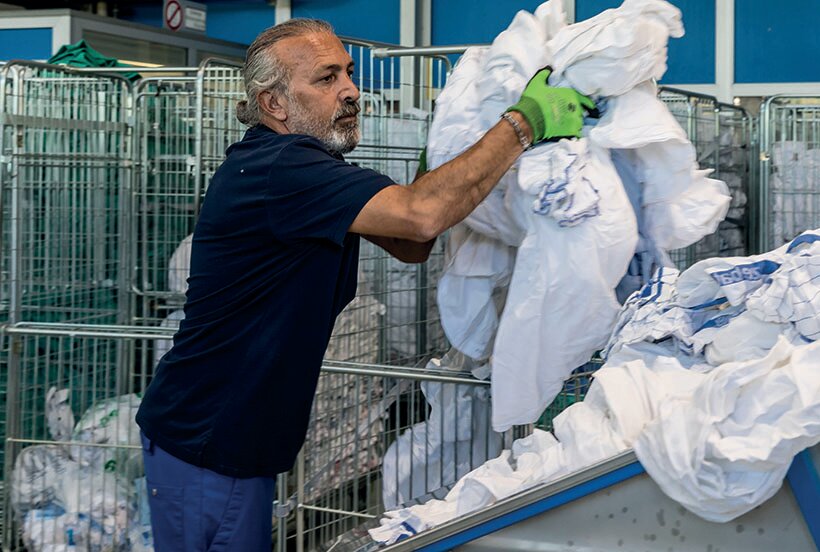
A key focus of the TSA’s sustainability drive is working with the hospitality industry to reduce the staggering volumes of linen that are lost, stolen, damaged or irretrievably stained each year at huge cost to operators and the environment.
“Each year the hotel industry loses over 12.5 million pieces of linen, which equates to 61% of the total stock of linen and towelling,” says Stevens. “Indeed, 50% of rented linen products last less than four months, well below the two-year working life they could achieve if looked after correctly.” Replacing this lost stock would take the equivalent of 937 million bathtubs of water just to grow the cotton and generate 39,000 tonnes of carbon.
‘Pasha the Pillow’ is the first of TSA’s planned series of animated video guides for hotel and laundry staff illustrating how correct handling will prolong the lifespan of linen – meaning not using pillows as substitute cleaning cloths or using duvets to prop open bedroom doors.
Jones concludes: “With the laundry room being one of the most resource-intensive area of a hotel, it’s even more important that laundry teams work alongside the machines in order to fully optimise the process. For example, one of the simplest ways to increase a dryer’s lifespan and reduce energy usage is to remove any build-up from the lint filter after every cycle. It should come as no surprise, but people are the most important part of the laundry process, after all.”
Laundry building blocks

JLA has a checklist for designing and installing energy saving, cost-effective on-premise laundries:
Location Ideally on the ground floor with at least one external wall for ventilation and ducting, and sited away from the main entrance, kitchen and bedrooms
Cross-contamination Channel workflow through a ‘soiled’ in-door and a ‘clean’ out-door
Layout Divide the room into one-third wet (drainage) and two-thirds dry (with dryer ducts and air inlet panels)
Insulation Install solid concrete floors to mute machine vibration and noise or add concrete slabs under heavy washers
Power Preferably a three-phase power supply but equipment requirements vary
Space Ensure service access around washers and dryers and room for plenty of shelving, a folding table, storage for essentials and ancillary equipment such as dryer ironers, rotary irons and hand-finishing ironing tables
Sun spots
Tanning lotions are a growing blot on the linen landscape, leaving serious stains that often cannot be removed without expensive treatment. The worst offenders are developer tanning creams, which can soil fabrics during the three to eight hours they take to develop.
TSA guidance advises hotels to educate guests to avoid contact with hotel linen during the tanning process by wearing onesies, and to shower off any residue after the development time. Another tactic is to encourage guests to switch to residue-free alternatives.
Washing to a tee
Stoke by Nayland, a luxury hotel, golf and spa resort near Colchester, turned to Girbau UK to upgrade its on-premise laundries to cope with increased laundry volumes.
The three 25kg-capacity HS-6023 washers and three 37kg ED 660 gas dryers mean the resort can now process all its hotel and spa laundry, outsourcing only specialist flatwork.
The washers process 15-16 daily loads of hotel towels in 45-minute cycles (spa towels take longer) and six to eight daily loads of hotel linen and restaurant napkins. The dryers can tackle 75lb loads in 25 minutes and their textile-friendly humidity control automatically activates cool-down when it senses the clothes are dry.
Suppliers
Girbau UK www.girbau.com
JLA jla.com
Micro-Fresh Technology www.microfresh.com
Miele Professional www.miele.co.uk/p
P&G Professional pgpro.co.uk
Richard Haworth www.richardhaworth.co.uk
Textiles Services Association www.tsa-uk.org
WashCo www.washco.co.uk



